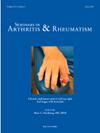Venous ulcers in Behçet syndrome
IF 4.6
2区 医学
Q1 RHEUMATOLOGY
引用次数: 0
Abstract
Introduction
Post-thrombotic syndrome (PTS) and stasis ulcers are late complications of deep vein thrombosis (DVT) in Behçet's syndrome (BS). We aimed to determine the clinical and histopathological characteristics, treatment modalities, and outcomes in BS patients with stasis ulcers.
Method
We included 63 BS patients with stasis ulcers from a total of 310 with vascular involvement, seen at a multidisciplinary center between January 2021 and July 2022. Data on demographics, clinical features, histopathology, radiology, and treatments were collected. Ulcer size, location, duration, and healing time were defined.
Results
Patients’ median age was 45 years, and age at vascular onset was 27 years. Except for 4 pts with only venous insufficiency, all had lower extremity DVT. Ulcers appeared a median of 3 years after vascular involvement onset and in 44 % healed imminently in a median of 6 months. At the time of evaluation in the current study, of the 63 patients with history venous ulcers, 35 (56 %) presented with active ulcers while the remaining presented with complete recovery of at least one-year duration. There were in total 202 ulcers with median ulcer size of 3 cm. 72 % were localized in the gaiter region. Histopathological examination was available for 21 pts. In 67 % (14/21), the diagnosis favored stasis dermatitis. No frank vasculitis was observed. Treatment included bed rest, local treatments, venous compression and immunosuppression. Patients received a combination of immunosuppressive agents, including biological DMARDs (75 %), non-biological DMARDs (97 %), and steroids (94 %). Despite these intensive therapies, ulcers remained unhealed in 17 %, and the recurrence rate was 73 % over a median follow-up of 16.8 years.
Conclusion
Leg ulcers are challenging complications of DVT in BS and represent an unmet medical need. Future studies should investigate the effectiveness of early immunosuppressive therapy, and other interventions in preventing venous ulcers and improving outcome.

求助全文
约1分钟内获得全文
求助全文
来源期刊
CiteScore
9.20
自引率
4.00%
发文量
176
审稿时长
46 days
期刊介绍:
Seminars in Arthritis and Rheumatism provides access to the highest-quality clinical, therapeutic and translational research about arthritis, rheumatology and musculoskeletal disorders that affect the joints and connective tissue. Each bimonthly issue includes articles giving you the latest diagnostic criteria, consensus statements, systematic reviews and meta-analyses as well as clinical and translational research studies. Read this journal for the latest groundbreaking research and to gain insights from scientists and clinicians on the management and treatment of musculoskeletal and autoimmune rheumatologic diseases. The journal is of interest to rheumatologists, orthopedic surgeons, internal medicine physicians, immunologists and specialists in bone and mineral metabolism.

 求助内容:
求助内容: 应助结果提醒方式:
应助结果提醒方式:


